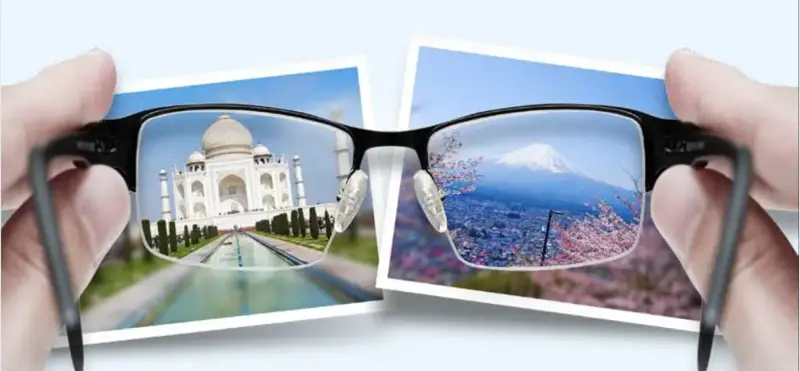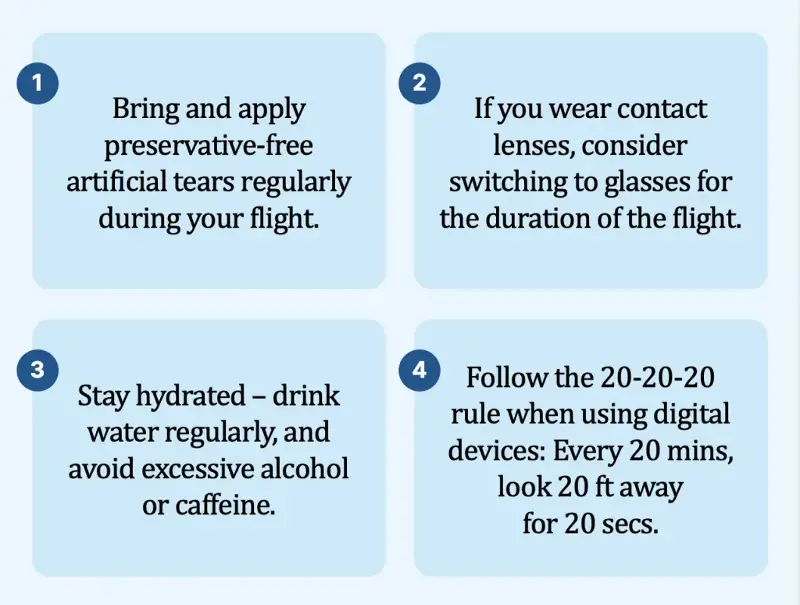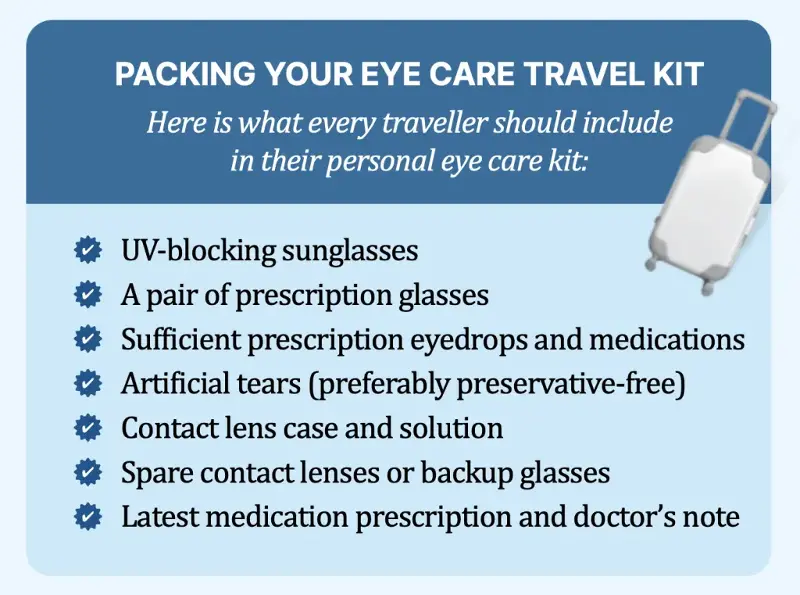
Of Vision and Vacations! Dr Khor Wei Boon’s Prime Magazine Article
As we head towards the end of the year, many of us will be travelling for holidays. But did you know travel eye care is just as important as planning your itinerary? Travelling can expose your eyes to dry cabin air, strong UV rays, changing temperatures, and unfamiliar environments that may stress your vision. In this article, I will explain how traveling affects your eyes and share practical travel eye care tips to keep them healthy during your vacation.
FLYING WITH DRY AIR AND DRY EYES
One of the most common eye complaints during air travel is dryness. The humidity in airplane cabins can be very low, creating an environment that is much drier than our typical Singapore weather. In this dry air, the tear film that normally keeps our eyes moist and comfortable evaporates faster than usual. The use of digital devices and inflight entertainment screens will also contribute to this dryness. All this results in a gritty, burning sensation, red eyes, or even intermittently blurred vision, particularly for people who already suffer from dry eye syndrome or who wear contact lenses. Proper travel eye care helps prevent discomfort during long flights.
What you can do:
1. Bring and apply preservative-free artificial tears regularly during your flight.
2. If you wear contact lenses, consider switching to glasses for the duration of the flight.
3. Stay hydrated – drink water regularly and avoid excessive alcohol or caffeine.
4. Follow the 20-20-20 rule when using digital devices: Every 20 mins, look 20 ft away for 20 secs.

Flying with dry air and dry eyes
UV EXPOSURE AND “SUNBURNS” OF THE CORNEA
It is no secret that ultraviolet (UV) radiation can damage our eyes over time. But we sometimes underestimate how our UV exposure is increased during travel, particularly on snowy slopes, by clear blue seas, or during high- altitude hikes.
UV rays can reflect off surfaces like snow, water, and sand, essentially doubling the amount of UV exposure to your eyes. This excessive UV exposure can damage the outer lining of the cornea, leading to a painful condition called photokeratitis. At higher altitudes, the thinner atmosphere also offers less UV protection; this is why skiers risk developing photokeratitis (also known as “snow blindness”) from the combination of UV rays reflecting off the snow and increased exposure from the sun. Photokeratitis is akin to having a sunburn on the cornea and can present a few hours after the UV exposure with painful, red, and teary eyes. Although it will typically recover in a few days, doctors will usually prescribe eyedrops and ointments to soothe the cornea, prevent infection, and speed up the recovery.
To protect your eyes:
- Always wear sunglasses with 100% UVA and UVB protection, even on cloudy days.
- 2.Choose sunglasses with wraparound styles that block light from the sides.
- Wear a wide-brimmed hat in sunny conditions.
- If skiing or mountaineering, invest in proper UV-protective goggles.

How to protect your eyes when travelling
CONTACT LENS WEAR AND EYE INFECTIONS
One of the thrills of travel is the chance to explore different countries, landscapes, and destinations. This also means exposure to different climates and environmental conditions – dry dusty roads, sweltering open-air markets or places with lower sanitation standards. There is also the urge to maximise your time during holidays, which may mean longer hours of lens wear, or skip the usual cleaning and soaking of contacts. These conditions can increase the risk of eye infections from contact lens wear.
Swimming in rivers or lakes while wearing contacts is particularly risky. One serious concern is acanthamoeba keratitis, a painful and vision-threatening infection caused by a parasite found in water. Acanthamoeba can also be present in tap water and is a common cause of contact lens-related eye infections in developed countries such as the United Kingdom. This parasite is notoriously difficult to treat, and patients may require months of eyedrops and even cornea transplant surgery to eradicate the infection.
To stay safe:
- Avoid swimming with contact lenses, even in swimming pools.
- Never rinse your contact lenses or lens case with tap water.
- Carry a multipurpose solution that is suitable for your contacts.
- Wash your hands thoroughly with water and soap before touching your eyes or lenses.
- Consider using daily disposable contacts while travelling, to avoid the hassle of cleaning, soaking, and storing your lenses.
- Always pack a pair of glasses, for when you cannot or should not be wearing contacts.
TRAVELLING WITH PRE-EXISTING EYE CONDITIONS
If you have a chronic eye condition, you will need to plan ahead before your trip. For example, people with glaucoma may need to adjust their drop schedules when crossing time zones to ensure they are not missing their dose. Some of the eyedrops used in glaucoma, such as prostaglandin analogues, can lose their effectiveness if exposed to high temperatures. Also, it can be difficult to purchase prescription eyedrops if you run out of them while abroad. So, be sure to bring enough supplies.

Packing your eye cre travel kit
While air travel is rarely prohibited if you have eye conditions, the one exception is if there was recent eye surgery (less than one month ago) in which a gas bubble was injected into the eye. Some of the gases used in eye surgery, such as sulphur hexafluoride or perfluoropropane, can expand due to the lower air cabin pressure on airplanes, resulting in a sudden, painful rise in eye pressure.
Before you travel:
- Consult your ophthalmologist, especially if you have had recent surgery or are experiencing unstable vision.
- Get a written note from your doctor, in case you need to seek medical attention while overseas.
- Pack temperature-sensitive medications in your carry- on luggage, not in checked bags (but consult the latest rules on carry-on luggage to determine if that
is possible). - Bring extra supplies, and ensure that your name is on the medication labels to prove that they
are your prescription medications.
JET LAG AND EYE STRAIN
Jet lag does not just affect your sleep – it can also take a toll on your eyes. Changes in your sleep cycle can disrupt tear production, while long hours of screen time during flights or layovers can cause dryness and eye strain. Add in the sleep disturbances caused by crossing time zones, and your eyes may feel as fatigued as the rest of your body. Other symptoms include irritation, redness, and a difficulty with focus. Fortunately, all these changes will normalise with time, as your body recovers from jetlag.
To minimise eye strain and fatigue:
- Take regular eye breaks according to the 20-20-20 rule, and use lubricating drops as needed.
- Avoid wearing contact lens temporarily if your eyes are already feeling uncomfortable.
- Try to get natural sunlight during the day to help reset your internal clock.
- The use of over-the-counter herbal remedies and melatonin supplements may help you to sleep at night
A LITTLE PREPARATION GOES A LONG WAY
We spend so much time planning the perfect holiday, but we often forget that a minor eye issue can easily disrupt our travel plans. Whether it is the discomfort of dry eyes or the more serious risk of infection from contact lens wear, your eyes deserve just as much attention as your itinerary. With a bit of foresight, you can prevent these travel-related eye problems and look forward to a wonderful vacation! PRIME
